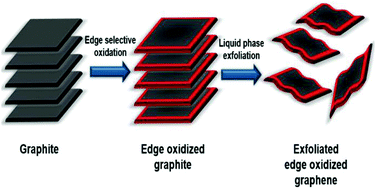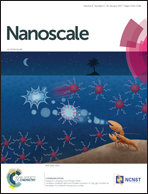Highly dispersible edge-selectively oxidized graphene with improved electrical performance†
Abstract
We prepared liquid phase exfoliated edge-selectively oxidized graphene (LPEOG) with a high concentration in water (∼14.7 mg ml−1) and a high ratio of a single layer (70%). The edge of graphite was selectively oxidized by step II oxidation of the modified Hummers method, and we subsequently exfoliated the edge-selectively oxidized graphite (EOG) into LPEOG. The edge selective oxidation of the LPEOG was confirmed by X-ray photoelectron spectroscopy (XPS), X-ray diffraction (XRD), zeta-potentiometry, Raman spectroscopy, Fourier-transform infrared spectroscopy (FT-IR), atomic force microscopy (AFM), and transmission electron microscopy (TEM). The highly concentrated LPEOG ink can be used in solution processing such as simple drawing or spin casting. Reduced LPEOG showed a higher conductivity (120 000 S m−1) than that of reduced graphene oxide (68 800 S m−1) despite the small lateral size. A transparent conducting film prepared from the LPEOG ink showed a lower surface resistance (∼2.97 kΩ sq−1) at a higher transmittance (>83.0 %T) compared to those of the graphene oxide based film. These results indicate that preservation of π-conjugation of the basal plane of graphene is critical for electrical performance of graphene. Our method facilitates solution processing of graphene for a wide range of applications.


 Please wait while we load your content...
Please wait while we load your content...